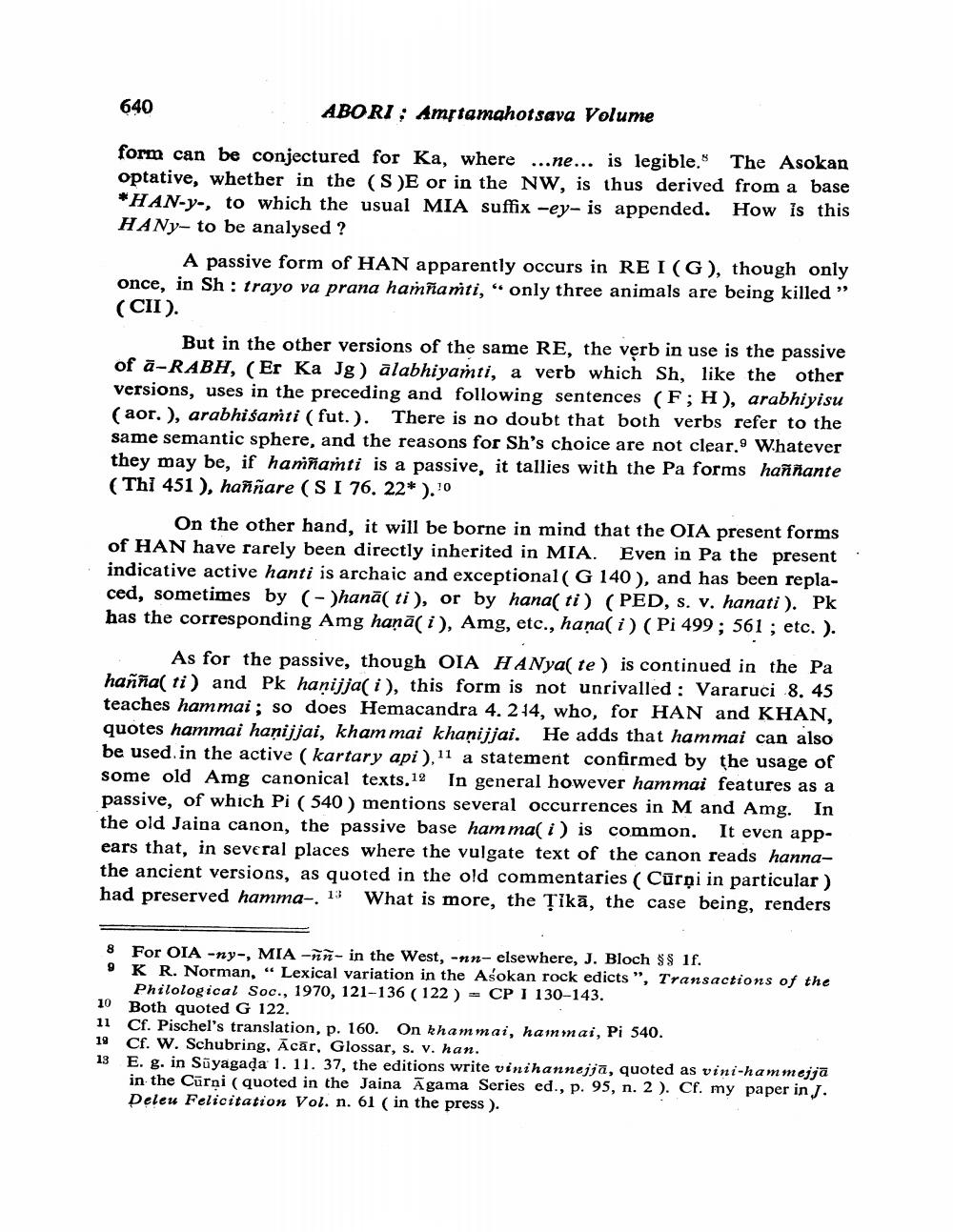Book Title: Double Optative Suffix In Prakrit Asoka XIII Na Hamnesu Na Hamneyasu Author(s): Colette Caillat Publisher: Colette Caillat View full book textPage 4
________________ ABORI; Amṛtamahotsava Volume form can be conjectured for Ka, where ...ne... is legible." The Asokan optative, whether in the (S)E or in the NW, is thus derived from a base *HAN-y-, to which the usual MIA suffix -ey- is appended. How is this HANY- to be analysed? 640 A passive form of HAN apparently occurs in REI (G), though only once, in Sh: trayo va prana hamñamti, "only three animals are being killed " (CII). But in the other versions of the same RE, the verb in use is the passive of a-RABH, (Er Ka Jg) alabhiyamti, a verb which Sh, like the versions, uses in the preceding and following sentences (F; H), arabhiyisu (aor.), arabhisamti (fut.). There is no doubt that both verbs refer to the same semantic sphere, and the reasons for Sh's choice are not clear.9 Whatever they may be, if hamñamti is a passive, it tallies with the Pa forms haññante (Thi 451), haññare (SI 76, 22*),10 On the other hand, it will be borne in mind that the OIA present forms of HAN have rarely been directly inherited in MIA. Even in Pa the present indicative active hanti is archaic and exceptional ( G 140), and has been replaced, sometimes by (-)hana( ti), or by hana( ti) (PED, s. v. hanati). Pk has the corresponding Amg hana(i), Amg, etc., hana(1) (Pi 499; 561; etc.). As for the passive, though OIA HANya( te) is continued in the Pa haññati) and Pk hanijja(i), this form is not unrivalled: Vararuci 8. 45 teaches hammai; so does Hemacandra 4. 214, who, for HAN and KHAN, quotes hammai hanijjal, khammai khanijjai. He adds that hammai can also be used in the active (kartary api), 11 a statement confirmed by the usage of some old Amg canonical texts.12 In general however hammai features as a passive, of which Pi (540) mentions several occurrences in M and Amg. In the old Jaina canon, the passive base hamma(i) is common. It even appears that, in several places where the vulgate text of the canon reads hannathe ancient versions, as quoted in the old commentaries (Carpi in particular) had preserved hamma-, 1 What is more, the Tika, the case being, renders 8 For OIA -ny-, MIA -nn- in the West, -nn- elsewhere, J. Bloch §§ 1f. 9 K R. Norman, Lexical variation in the Aśokan rock edicts", Transactions of the Philological Soc., 1970, 121-136 (122) CP I 130-143. 10 Both quoted G 122. 11 Cf. Pischel's translation, p. 160. On khammai, hammai, Pi 540. 19 13 Cf. W. Schubring, Acar, Glossar, s. v. han. E. g. in Suyagada 1. 11. 37, the editions write vinihannejja, quoted as vini-hammejjā in the Curni (quoted in the Jaina Agama Series ed., p. 95, n. 2). Cf. my paper in J. Deleu Felicitation Vol. n. 61 (in the press).Page Navigation
1 2 3 4 5 6 7 8 9
